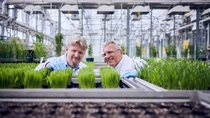Sustainability
BASF Research Press Conference 2021: Sustainability Starts in Research
December 9, 2021
With its innovative processes and products, the chemical industry makes an important contribution to reducing greenhouse gas emissions. BASF researchers are already contributing to making the sustainability transformation possible through their work.
Current innovation examples from BASF’s research pipeline for mobility and agriculture, such as innovative coolants for electric cars or new precision application technologies for agriculture, were presented today at the company’s Research Press Conference by Dr. Melanie Maas-Brunner, Member of the Board of Executive Directors and Chief Technology Officer of BASF SE, along with BASF scientists.
“The transformation towards sustainability starts in research,” said Maas-Brunner. BASF is very well-positioned here and has a unique research and development setup with around 10,000 employees globally. “To overcome the challenges of this transformation at an even faster pace and be successful in the long term, we must further strengthen customer proximity and leverage the advantage of our Know-how Verbund,” added Maas-Brunner. For this reason, the company is reorganizing its worldwide research activities in the coming year. Business-related research units, which have so far been part of the three research divisions, will be embedded into the operating divisions and thus even more closely aligned with the needs of customers. In the future, BASF will bundle research activities with relevance for several divisions in a central research division with global presence.
BASF has set itself ambitious sustainability goals. The company wants to further accelerate the development of CO2-free processes and a circular economy as well as the expansion of digitalization. Moreover, BASF supports its customers in the transformation toward greater sustainability: In total, BASF invested around €2 billion in research and development in 2020.

Increasing safety in e-mobility
The transportation sector accounts for a substantial share of global CO2 emissions. The transformation to e-mobility can reduce these emissions. For this to succeed, innovations are necessary, for example, to shorten battery charging times, increase safety and make the production processes of electric vehicles more sustainable and more efficient.
Chemistry will play a key role here: The chemical content of an electric vehicle (EV) is considerably higher than that of a vehicle with an internal combustion engine. This is because many of the other components in EVs change as a result of the modified powertrain. BASF’s research and development is continuously working on innovative products for electric vehicles, such as battery materials, high performance plastics, modified coolants and novel coatings.
Plastics, for instance, make an important contribution to safety in electric vehicles. For example, they are used to achieve stable impact protection and safe electricity distribution, as thermally conductive adhesives and to color-code high-voltage components and connectors.
A newly developed coolant from the Glysantin® product range is another BASF product that further enhances safety in EVs. It has exceptionally low electrical conductivity thanks to its novel formulation. This means that if the battery is damaged, for example, in an accident, the new BASF product does not react with high-voltage battery components. At the same time, Glysantin® ElectrifiedTM offers reliable corrosion protection in the cooling system of electric vehicles.
With the help of digital methods, BASF researchers have also developed a new version of their cathodic electrocoat (e-coat) CathoGuard® specifically designed to meet the requirements of electromobility. It enables application at lower temperatures, thus reducing CO2 emissions while maintaining the same product properties. In addition, the technology meets established sustainability standards as it is free of tin and hazardous air pollutants and contains only a low level of volatile organic compounds.

Innovations for sustainable agriculture
BASF research is also working on solutions for sustainable agriculture. Farmers are facing major challenges: feeding a growing world population that will reach 10 billion by 2050, changing weather conditions due to climate change, safe and effective pest and weed control amid increasing resistance as well as limited natural resources and arable land. Innovations – ranging for example from new seeds and traits to novel crop protection products and digital applications – are therefore urgently needed.
Wheat is one of the world’s most important grains, with a volume of over 770 million metric tons per year. Wheat yield must be increased significantly in the coming years. This goal will be harder to reach because of limited arable land and crop failures caused by climate change. Through a globally driven, locally tailored breeding program, BASF develops new hybrid wheat with value-added traits for increased yield and quality as well as disease and insect resistance. By utilizing diverse genetics from key wheat-growing regions, BASF researchers select the best plant traits from genetically distinct parental lines. With this, the company addresses the needs of farmers and partners along the entire value chain to enable yield stability as well as better climate resilience.
To optimize crop production, BASF has developed an intelligent plant modelling platform that delivers precise agronomic recommendations based on continual data analysis. It processes economic, biological and sustainability parameters to provide digital agronomic consulting to farmers, enabling them to achieve efficient and environmentally sound crop cultivation. The platform data is used in various products from xarvio® Digital Farming Solutions. For example, in Smart Spraying developed with Bosch, the data is paired with high-tech camera sensors and software to spot apply herbicide to weeds only where needed. Field trials show that this combination of technology can deliver herbicide volume savings of up to 70%. This represents an important contribution to environmental protection while offering financial benefits for farmers.
Changes to research design – shifting from sequential to parallel research – also represent a trail-blazing approach for sustainable innovations. With this methodology, products and applications are developed holistically from the very beginning and sustainability aspects are taken into account in the early R&D stages. BASF successfully developed the new fungicide Revysol® in this way. This active ingredient from the chemical class of triazoles demonstrates strong biological performance against a number of relevant fungal diseases. At the same time, it meets all requirements for safe and environmentally compatible application.